Grand Ethiopian Renaissance Dam Case Study: Characteristics Of Complexities
Question
Task: Your tasks as follow:
1) you need to discuss the applicability of the complexity characteristics to the case of GERD dam. This means you need to analyses and discuss the following:
- Do you agree with the defining characteristics of complexity in projects as it is? Or you think these characteristics have different order in the case of GERD?
- Explain why do you think so? What is your rationale and how do you see these characteristics in the case of the GERD?
2- After defining the characteristics of the GERD, you need to sum up similar characteristics in one of the main four complexity types (Structural, Technical, Temporal or Directional) and identify what is the most significant complexity type in the GERD.
3- You are requested to initiate a scorecard (using any of the complexity estimation tools) to ROUGHLY estimate the complexity of the GERD project. This requires you to do the following:
- A) Conduct a survey to assign weights for each complexity factor. You may need to ask your peers (students from your tutorial and class), lecturers. to take part in this survey (minimum of 15 volunteers)
- B) Your discussion should include a list of all interviewees with their contact details/ name
Answer
1. Applicability of the complexity characteristics
a) Defining characteristics of complexity in projects – Grand Ethiopian Renaissance Dam case study
The GERD Project examined in the Grand Ethiopian Renaissance Dam case study focused on improving the quality of water supply to the audiences. This has been observed that GERD is recognized to be one of the leading water management projects in Egypt. Any project faces several forms of complexities that can negatively affect the project stages in the end. There are mainly four kinds of complexities that are faced by the project manager while accomplishing GERD project in Egypt. It is noted that the complexities comprise of structural complexity, technical complexity, directional complexity and temporal complexity. Further, it is imperative for the project manager of GERD to mitigate the complexities that are identified while completing the project (Moore, Payne, Autry &Griffis, 2018). On the other hand, the complexities can negatively influence the growth and development of project process in the end. In accordance to the Grand Ethiopian Renaissance Dam case study, one of the key complexities that have been identified is the inclusion of foreign companies in each section of the project (Bjorvatn& Wald, 2018). The need for invasion of foreign entities was possible due to geographical vastness of the project. Therefore, it enhanced the chance of ‘Structural Complexity’ in the GERD project. On the other hand, several components related to geographical aspects such as human intervention and natural growth enhanced the risk of structural complexity in the GERD project. Moreover, the involvement of nations such as Sudan, Egypt and Ethiopia made it difficult for GERD project to be accomplished. In order to accomplish a project appropriately, the nations are required to collaborate and support the cause. However, in context to this particular project discussed in the Grand Ethiopian Renaissance Dam case study, the nations did not collaborate that created structural complexity.
The next complexity that has been identified in the GERD project as mentioned in the Grand Ethiopian Renaissance Dam case study is ‘Technical Complexity’. Incorporation of effective and advanced technology can be determined as imperative for growth of a project in an effective manner (Matinheikki, Aaltonen& Walker, 2019). This has been observed that Bureau of the United States has conducted and executed project plan in context to GERD project. Yet, the solution related to this project was derived from the outcome of the survey that cannot be determined was the actual need of the execution team. Therefore, it negatively influences the project execution process in the end. This needs to be mentioned that technical complexities rose due to implication of outdated and ineffective tools and technologies. Thus, it can be stated that it is important for the project team to develop appropriate solution for mitigating challenges and risks related to technical complexities, which is present in GERD project (Turner, Aitken &Bozarth, 2018). As the project mainly deals with water management in the Nile River, therefore, uncertainty can be determined as one of the major complexities that are faced by the project manager while establishing GERD project.
This form of complexity generally derives from uncertainties in the water flow of the Nile River. Hence, this kind of complexity can be regarded as ‘Directional Complexity’. Hence, the readings used from the Grand Ethiopian Renaissance Dam case study mentions that it is difficult for the project team of GERD to identify and design required components of structures for making project successful in the end. For instance, if a nation, suppose, Sudan does not acquire the capacity to handle water volume, then, it can negatively influence the economic aspect. This will create financial loss for the country. Therefore, the project manager is required to develop a plan that identifies and reduces the impact of directional complexity. Political disagreements are another key factor that enhances the chance of complexities in the development of project (Rumeser & Emsley, 2019). This kind of complexity is known as ‘Temporal Complexity’. The political instability in Egypt has adversely impact of the GERD project. This political disagreement generally is associated with sharing Nile River as a part of the Nile Basin initiative. Further, rising funding from the foreign investor has been another major difficulty for Egypt government. Therefore, it increased the risk of temporal complexity in the GERD project.
b) Rationale
In accordance to the Grand Ethiopian Renaissance Dam case study, there is a presence of several complexities that negatively influence the growth and brand image of GERD project. This needs to be mentioned that elimination of complexities through using appropriate strategies and methods will help in completing GERD project effectively. The participation of government is imperative and necessary for accomplishing project goals (Misra, Adewumi, Fernandez-Sanz&Damasevicius, 2018). However, it has been evident from the Grand Ethiopian Renaissance Dam case study that there has been lack of participation of government of nations such as Egypt, Sudan and Ethiopia. Hence, this negatively affected the growth and completion of the project. Moreover, using ineffective technologies created number of technical complexities (Islam, Gyoshev&Amona, 2018). Thus, four of the complexities were present in the GERD project that created barriers in the project development process.
2. Identify and examine significant complexity type in the GERD
Similar characteristics in directional complexity
Considering the complexities that are present in the GERD project, it has been noted that most of the project failure factors are based on the directional complexity character as defined in terms of project management process. The GERD project contains a range of similar complexities as that has been defined in directional complexity characteristics in a project process. These similar characteristics are based on few aspects that have been defined considering the potential failure that has been attained in the GERD project.
- It has been noted that the GERD project involved the presence of unhelpful behaviour from the management employees and the local authority, whom were assigned with respective activities to complete the project. This indicates the characteristics that there was lack of stakeholder participation as the employees are the key stakeholders in an organisation or project process. On the other hand, it can be noted that the local authority did not approve for the project as per the consideration to protect the future conducted by the local authority. This has led to a reduction in fund amount for the project, which further delayed the completion, and more complexities were attained (Hussein, 2019).
- In the directional complexity, it can be noted that there can be lack of productive information sharing among the stakeholders, which has been identified in the GERD project as well. It has been noted that there was a lack of effective communication among the employees and the managers regarding the deployment of the project information of the population, the government and other respective individuals (Metzger et al. 2017).
- It is to be noted in the Grand Ethiopian Renaissance Dam case study that every project must attain productive support from the different team members belonging to the different departments as all the teams are aligned to be working on a common goal. The lack of productive working support from the employees is another similar complexity that has been present in the GERD project. The project lacked appropriate support from the teams by means of absence of leadership strategies and productive motivation to be given to the employees.
The characteristics identified by performing the critical analysis on the Grand Ethiopian Renaissance Dam case study indicate that the project management process of the GERD project was not developed sufficiently to manage the presence of productivity at higher costs. This indicates that the GERD project has undergone large amount of directional complexities which has been related to the communication gap present among the stakeholders of the company and lack of effective support from the governmental bodies to ensure that the project is conducted keeping the betterment of the population.
Significant complexity type in the GERD
Considering a range of complexities that are presenting the GERD project and the identified complexity type of directional complexity it can be stated that it is important for the company to reduce and mitigate the presence of directional complexity types along with the removal of temporal complexities, which might arise occasionally. It has been noted that the directional complexities arise due the mismatch that occurs among the stakeholders and other perspectives shareholders of the company or the project. This further indicates that the GERD is highly impacted by the presence of the disputes among the local authorities and project managers on the development of the project (Salman, 2018). The removal of the conflict is important to ensure that the project is being completed by carrying out productive situational analysis of the conflict. The presence of communication gap among the teams leads to reduction in the overall performance of the project and further leads to slow project completion.
On the other hand, it can be identified that the presence of temporal complexities like the unhelpful behaviours’ presence and lack of funding has led to the development of the inappropriate management in the GERD project. The critical analysis on the Grand Ethiopian Renaissance Dam case study illustrates that this inappropriate management process has restricted the completion of the project, which is further creating chaos in the development process of the project and has led to the conflict arising among the stakeholders leading to the rejection of the agendas that has been set up to mitigate the complexities present (Majumder, 2017). The conflict present and the request that has been made by the Egyptian government for fund approval so that the project could be completed on time and with perfection indicates that the presence of directional complexity is highly important to be mitigated. This further leads to higher rate of project sustainability and ensures that there is lack of errors present in the project, which might reduce the overall quality of the entire GERD project outcome (Bakhshi, Ireland & Corral De Zubielqui, 2015).
3. Discussion on the survey result in the context of Grand Ethiopian Renaissance Dam case study
Discussion: As discussed in the previous section that there is presence of several complexities in the GERD project, thus, understanding the rationale behind is important. Hence, survey process has been conducted for obtaining accurate and relevant data for gaining in-depth knowledge in context to the GERD project. The section will help in reflecting on different aspects and attributes related to the GERD project.
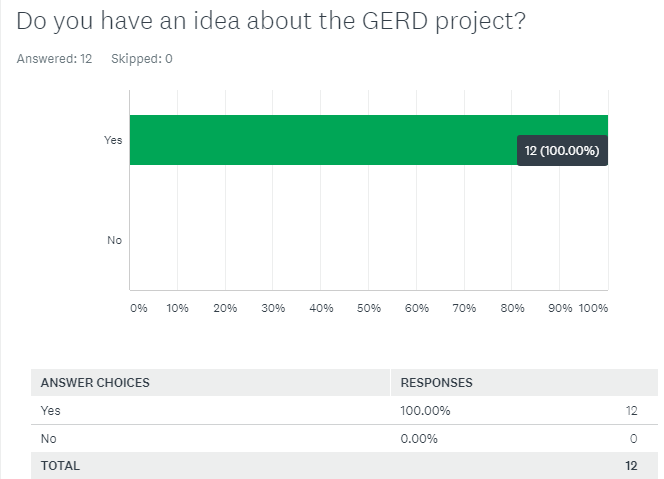
The above graphical representation shows that number of respondents acquires information and knowledge related to GERD project. Therefore, it can be stated that obtaining ideas and information about GERD project will help in attaining project goals and objectives effective manner.
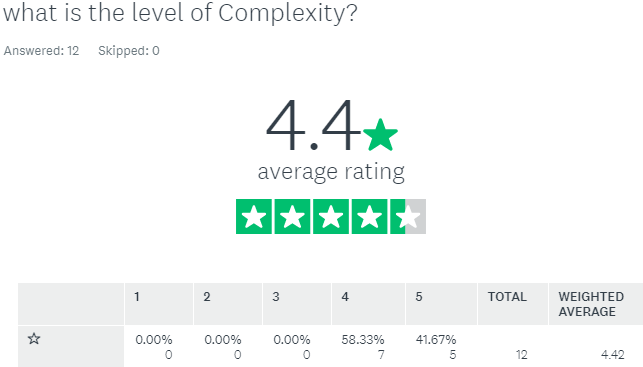
This has been observed from the survey process basis the Grand Ethiopian Renaissance Dam case study that the complexity level of the GERD project is severe in nature. Hence, the average rating is 4.4, which shows that there is availability of different kinds of complexities such as technical, structural and temporal complexity. Therefore, it can be stated that there is high tendency for enhancement of complexities in the GERD project due to lack of involvement of government of three nations. These nations are Sudan, Egypt and Ethiopia.
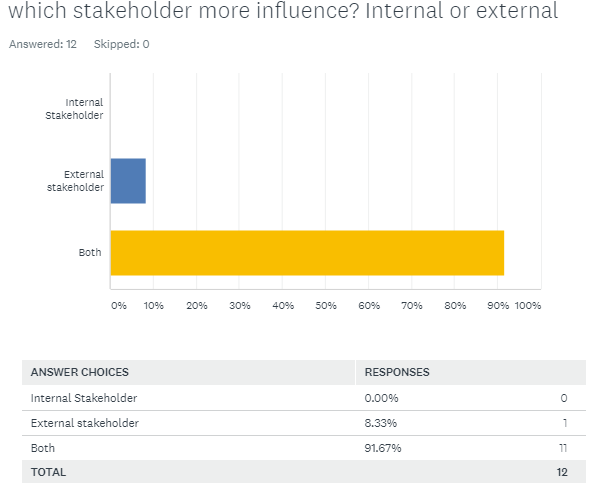
The survey result shows that both internal and external stakeholder influences the project of GERD for attaining effective competitive advantage. In addition to that, the respondent’s thinks that involvement of external stakeholders is higher as compared due to implications of different policies and regulation abided by the government of respective nations.
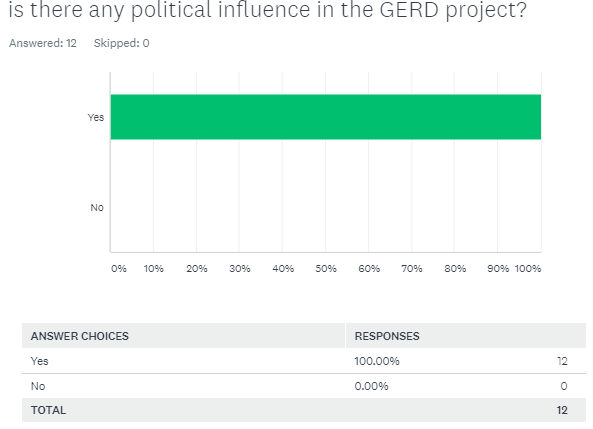
In context to the survey process done within this Grand Ethiopian Renaissance Dam case study analysis, there is a presence of political influence in the GERD project. This has been observed from the Grand Ethiopian Renaissance Dam case study that political aspects and attributes make an impact on development and accomplishment of project goals and mission appropriately.
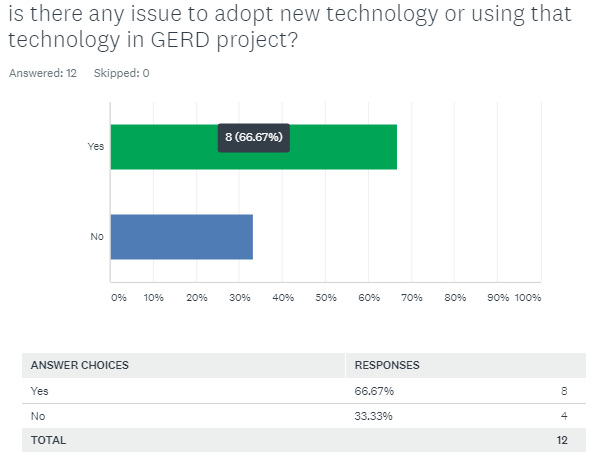
Majority of respondents surveyed to prepare this Grand Ethiopian Renaissance Dam case study analysis have agreed that various issues that are related with GERD project will require adoption of new technology. In other words, implementation of advanced tools and technologies will be beneficial for project manager to complete GERD project within due time.
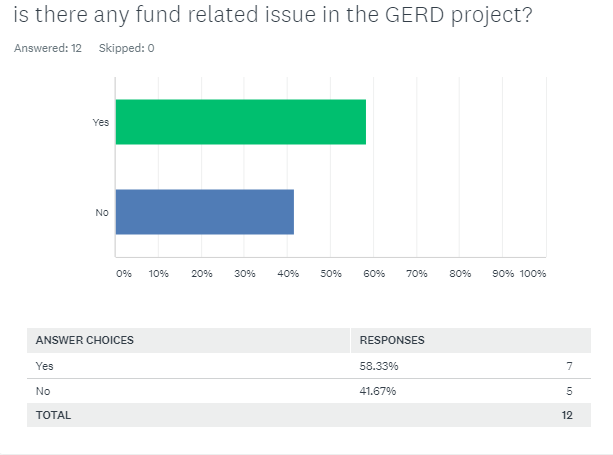
The above survey result based on the Grand Ethiopian Renaissance Dam case study analysis shows that more than 58% of respondents believed that there is presence of fund related problems in the GERD project. Thus, it can negatively impact on the growth and development of the project. However, approximately 42% respondents think that there is no as such fund related problems related to the project. This can be stated that knowledge related to financial aspect is unclear among respondents.
4 What are the GERD Dam project complexities and PM Skills identified from the Grand Ethiopian Renaissance Dam case study?
Skills and competencies for managing GERD dam complexity
|
GERD dam complexity |
Skills and competencies |
|
Multiple stakeholders |
Competent |
|
Political influence |
Advance Beginner |
|
Technology issue |
Expert |
|
Fund related issues |
Proficient |
The discussion based on the entire Grand Ethiopian Renaissance Dam case study represents skills and competencies and complexity aspects at GERD dam. A project manager should have the required skills and competencies to manage GERD dam complexities. GERD dam complexities include major characteristics of complex projects such as multiple stakeholders, the ambiguity of project, political influences, inadequate fund, significant external influences, technology issues, highly regulated environment and project duration cycle. These complexities that are observed in GERD dam need to be addressed adequately. To discuss the level of sophistication, skills and competencies that a project manager should have consist of competent, advance beginner, expert and proficient skills.
GERD dam complexity includes the level of complexity as the significant issue that weights 4.4 ratings from a survey process. The level of complexity is severe while analyzing the results. Therefore a project manager must consider skills and complexities that solves the problem of complex projects (Hall-Ellis &Grealy, 2013). The skills and competencies that can be used for solving issues like stakeholder influence, political influence, technology and fund-related matters.
External Stakeholders
External stakeholders respond to a complicated situation while considering different policies and regulations which affects the project management. Government involvement tends to change the project management stage, which leads to project delay. The skills used for managing multiple stakeholders consist of competent level because the competent ability is the stage to which things get exciting and rules are followed considering the application of practical steps to manage the grip of a project. Therefore to encounter the situation mentioned in the Grand Ethiopian Renaissance Dam case study, the rules are followed, and clear objectives are achieved while focusing on competitive advantage and gaining a significant prospect of growth. Some rules should be ignored by project management as the risk gets paralyzed in terms of indecision and particular purpose (360 PMO, 2018). This will majorly lead to confusion. Therefore correct decision taken by project managers in certain situations is recommendable. In the middle ground of the model, project managers should be fully capable of solving problems and planning for the future with practical actions such as getting exact details of the projects and solving the issues of a team to smoothen the process of project management.
Political influence
The problem of political power can be solved in terms of advance beginners skill. Advanced beginner’s power dwells in a world that unfortunately aims at acquiring results to the best while gaining knowledge in a particular field (Patterson, 2017). Political influences in GERD dam project include control of the government and political parties involved in the GERD project. The presence of complex situations needs practical solutions to be considered with an impact to accomplish the project in a particular time frame. Advanced beginner’s skill is a level of expertise required for project managers to handle the situation and focus on project accomplishment and mission in an appropriate manner.
Technological issues
Technology issue illustrated in the Grand Ethiopian Renaissance Dam case study is the complicated situation that GERD dam project faces in terms of the traditional use of technology in GERD dam project. Experts can highly manage technology aspects, and a complicated situation can be solved effectively. Therefore, to maintain the technological element, expert knowledge and skills are used in the GERD project. The project manager should be expertise and should handle the project effectively with information and knowledge in the context of managing the project while gaining expertise in technological aspects. New tools and technology will ensure project completion within due time.
Fund related issues
The complicated situation of fund pertaining problems needs to be managed effectively with proficient skills by a project manager. However, it is essential that self-improvement skills and experience matter on the scale to gain knowledge and raise funds. Government and non-government organizations should be addressed to increase fund and accumulate resources appropriately. Therefore, to understand essential framework proficient skills, including observing skills and source of information is essential in managing GERD dam project.
Level of skill
The usage of Dreyfus model in regards with the Grand Ethiopian Renaissance Dam case study ensures level of skills of individual to perform an activity. The level of skills required to consider the complex situation in managing GERD dam project is described in detail.
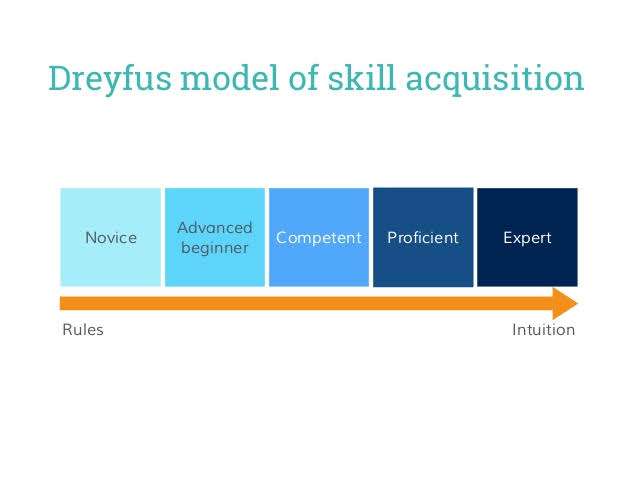
Source: (Hall-Ellis &Grealy, 2013)
The level of skill required indicates the major aspects of growth for a project manager to perform in a situation and gain project management skill.
Novice: Novice skills are required to manage project management situations appropriately. Being a learner is to gain experience in terms of particular skills and handle the performance of a project (Atlanta 2013). Therefore novice skill required is 20% as per the graph and the complicated situation to be treated in terms of handling the GERD dam project. There is no experience needed, and no change of perspective can be considered within a person with performance ability. The managing team hardly consists of novices as being a novice is a starting struggle to become advance beginners.
Advanced beginner: Advance beginner skills are required to which an individual helps in considering troubleshooting the issues and acquiring results immediately.
Competent: The findings of the Grand Ethiopian Renaissance Dam case study used within this report signifies that the competent skill is considered at the middle ground of the model as it involves skills of troubleshooting, experience pinpointing details, IT spheres, etc. Therefore, 30% of competent level skills are essential to handle the project effectively.
Proficient: Proficient level skills are required by project managers to handle the complicated situation. Approximately 10% of the proficient skills are necessary for managing the project while considering the technological aspect.
Expert: Expertise level skills should be adopted by project managers to 5% so that the GERD project can be handled effectively. The experts will handle the situation with the level of experience and intuition that look forward to managing change in the project. Expertise ensure team leads, conduct studies and research to find practical solutions.
Conclusion
The discussion on the basis of readings from the Grand Ethiopian Renaissance Dam case study represented the identification of skills and knowledge for project managers to manage the complicated situation in terms of GERD dam project. Therefore, the level of expertise required in managing the complex issues at the GERD dam project was adequately described in a table and graph. With the help of the Dreyfus model, the skills needed to handle the situation and the level of suitability was described in detail with novice, advanced beginner’s, competent, proficient and expert level. The skills were described in detail in the above context of Grand Ethiopian Renaissance Dam case study while managing the complicated situation such as multiple stakeholders’ interest in GERD project, technological issues, political influences and fund related issues at GERD dam project.
References
Atlanta, 2013, Dreyfus Five Stage Model of Adult skills Acquisition applied to engineering lifelong learning, Grand Ethiopian Renaissance Dam case study 120th ASEE Annual Conference & Exposition, pp. 1-13.
Bakhshi, J., Ireland, V., & Corral De Zubielqui, G. (2015).Exploring project complexities: a critical review of the literature.InAIPM National Conference. Hobart, Australia.
Bjorvatn, T., & Wald, A. (2018).Project complexity and team-level absorptive capacity as drivers of project management performance. International Journal of Project Management, 36(6), 876-888.
Hall-Ellis, S, Grealy, D. (2013). The Dreyfus model of skill acquisition: A career development framework for succession planning and management in academic libraries. Grand Ethiopian Renaissance Dam case study College and Research Libraries, 587-605.
Hussein, H. (2019). The Grand Ethiopian Renaissance Dam and the Nile Basin: implications for transboundary water cooperation.
Islam, N., Gyoshev, S., &Amona, D. (2018).External complexities in discontinuous innovation-based R&D projects: Analysis of inter-firm collaborative partnerships that lead to abundance.Technological Forecasting and Social Change.
Majumder, M. (2017).THE BLIND MEN, THE ELEPHANT AND THE WELL: A PARABLE FOR COMPLEXITY AND CONTINGENCY.Water Diplomacy in Action: Contingent Approaches to Managing Complex Water Problems, 1.
Matinheikki, J., Aaltonen, K., & Walker, D. (2019).Politics, public servants, and profits: Institutional complexity and temporary hybridization in a public infrastructure alliance project. International Journal of Project Management, 37(2), 298-317.
Metzger, J. P., Esler, K., Krug, C., Arias, M., Tambosi, L., Crouzeilles, R., ...& Garcia, L. C. (2017). Grand Ethiopian Renaissance Dam case study Best practice for the use of scenarios for restoration planning. Current opinion in environmental sustainability, 29, 14-25.
Misra, S., Adewumi, A., Fernandez-Sanz, L., &Damasevicius, R. (2018). A suite of object oriented cognitive complexity metrics. IEEE Access, 6, 8782-8796.
Moore, C. B., Payne, G. T., Autry, C. W., &Griffis, S. E. (2018).Project complexity and bonding social capital in network organizations. Group & Organization Management, 43(6), 936-970.
Patterson, R. (2017). Use the Dreyfus Model to Learn New Skills, Grand Ethiopian Renaissance Dam case study Available at: https://collegeinfogeek.com/dreyfus-model/
Rumeser, D., &Emsley, M. (2019). Can serious games improve project management decision making under complexity?. Project Management Journal, 50(1), 23-39.
Salman, S. M. (2018). AGREEMENT ON DECLARATION OF PRINCIPLES ON THE GERD: INTERDEPENDENCE OR LEVELING THE NILE BASIN PLAYING FIELDP.Complexity of Transboundary Water Conflicts: Enabling Conditions for Negotiating Contingent Resolutions, 145.
Turner, N., Aitken, J., &Bozarth, C. (2018).A framework for understanding managerial responses to supply chain complexity. Grand Ethiopian Renaissance Dam case study International Journal of Operations & Production Management, 38(6), 1433-1466.
360 PMO, (2018). The five Dreyfus Model stages, Available at: https://www.360pmo.com/the-five-dreyfus-model-stages/












